Energy-Storage-Based Smart Electrical Infrastructure and Regenerative Braking Energy Management in AC-Fed Railways with Neutral Zones
Abstract
1. Introduction
2. Regenerative Braking Energy Utilization Schemes
- Power quality improvement;
- Peak cutting and valley filling;
- Active control for line voltage;
- Emergency power supply.
3. Description of the Modified System
3.1. Regenerative Braking Energy Utilization
3.2. Power Quality Improvement
3.3. Peak Cutting and Valley Filling Control
3.4. Management and Control for Clean Energy
3.5. Active Control for Line Voltage
3.6. Emergency Power Supply
4. Control Algorithm for Utilization of RBE
4.1. Algorithm Principles
4.2. Algorithm Steps
5. Results Verification and Analysis
5.1. Feasibility Evaluation of the Modified System
5.2. Advantage Evaluation of the Modified System
6. Conclusions
- Utilization of regenerative braking energy;
- Power quality improvement;
- Peak cutting and valley filling;
- Management and control for clean energy;
- Active control for line voltage;
- Emergency power supply.
Author Contributions
Funding
Conflicts of Interest
References
- Douglas, H.; Roberts, C.; Hillmansen, S.; Schmid, F. An assessment of available measures to reduce traction energy use in railway networks. Energy Conv. Manag. 2015, 106, 1149–1165. [Google Scholar] [CrossRef]
- The International Energy Agency (IEA) and the International Union of Railways (UIC). Railway Handbook: Energy Consumption and CO2 Emissions. Available online: https://www.iea.org/topics/transport/railwayhandbook (accessed on 3 October 2019).
- Bukarica, V.; Tomsic, Z. Design and evaluation of policy instruments for energy efficiency market. IEEE Trans. Sustain. Energy 2017, 8, 354–362. [Google Scholar] [CrossRef]
- Pankovits, P.; Pouget, J.; Robyns, B.; Delhaye, F.; Brisset, S. Towards railway-smartgrid: Energy management optimization for hybrid railway power substations. In Proceedings of the 5th IEEE PES Innovative Smart Grid Technologies Conference Europe (ISGT Europe), Istanbul, Turkey, 12–15 October 2014. [Google Scholar]
- Hernandez, J.C.; Sutil, F.S. Electric vehicle charging stations feeded by renewable: PV and train regenerative braking. IEEE Latin Am. Trans. 2016, 14, 3262–3269. [Google Scholar] [CrossRef]
- Aguado, J.A.; Racero, A.J.S.; De La Torre, S. Optimal operation of electric railways with renewable energy and electric storage systems. IEEE Trans. Smart Grid. 2018, 9, 993–1001. [Google Scholar] [CrossRef]
- Hayashiya, H.; Itagaki, H.; Morita, Y.; Mitoma, Y.; Furukawa, T.; Kuraoka, T.; Fukasawa, Y.; Oikawa, T. Potentials, peculiarities and prospects of solar power generation on the railway premises. In Proceedings of the 2012 International Conference on Renewable Energy Research and Applications (ICRERA), Nagasaki, Japan, 11–14 November 2012. [Google Scholar]
- Bocharnikov, Y.V.; Tobias, A.M.; Roberts, C.; Hillmansen, S.; Goodman, C.J. Optimal driving strategy for traction energy saving on DC suburban railways. IET Electr. Power Appl. 2007, 5, 675–682. [Google Scholar] [CrossRef]
- Li, L.; Dong, W.; Ji, Y.D.; Zhang, Z.K.; Tong, L. Minimal-energy driving strategy for high-speed electric train with hybrid system model. IEEE Trans. Intell. Transp. Syst. 2013, 14, 1642–1653. [Google Scholar] [CrossRef]
- Johnson, P.; Brown, S. A simple in-cab schedule advisory system to save energy and improve on-time performance. In Proceedings of the IET Conference on Railway Traction Systems (RTS 2010), Birmingham, UK, 13–15 April 2010. [Google Scholar]
- Li, Y.; Tomas, L.; Per, L. Achieving energy-efficiency and on-time performance with Driver Advisory Systems. In Proceedings of the 2013 IEEE International Conference on Intelligent Rail Transportation Proceedings, Beijing, China, 30 August–1 September 2013. [Google Scholar]
- Wang, Y.; Hou, Z.S.; Li, X.Y. A novel automatic train operation algorithm based on iterative learning control theory. In Proceedings of the 2008 IEEE International Conference on Service Operations and Logistics, and Informatics, Beijing, China, 12–15 October 2008. [Google Scholar]
- Li, Z.X.; Yin, C.K.; Jin, S.T.; Hou, Z.S. Iterative learning control based automatic train operation with iteration-varying parameter. In Proceedings of the 2013 10th IEEE International Conference on Control and Automation (ICCA), Hangzhou, China, 12–14 June 2013. [Google Scholar]
- Hayashiya, H.; Yokokawa, S.; Iino, Y.; Kikuchi, S.; Suzuki, T.; Uematsu, S.; Sato, N.; Usui, T. Regenerative energy utilization in a.c. traction power supply system. In Proceedings of the 2016 IEEE International Power Electronics and Motion Control Conference (PEMC), Varna, Bulgaria, 25–28 September 2016. [Google Scholar]
- Hayashiya, H.; Kikuchi, S.; Matsuura, K.; Hino, M.; Tojo, M.; Kato, T.; Ando, M.; Oikawa, T.; Kamata, M.; Munakata, H. Possibility of energy saving by introducing energy conversion and energy storage technologies in traction power supply system. In Proceedings of the 2013 15th European Conference on Power Electronics and Applications (EPE), Lille, France, 2–6 September 2013. [Google Scholar]
- Hayashiya, H.; Nakao, Y.; Aoki, Y.; Kobayashi, S.; Ogihara, M. Comparison between energy storage system and regenerative inverter in D.C. traction power supply system for regenerative energy utilization. In Proceedings of the 2017 19th European Conference on Power Electronics and Applications (EPE’17 ECCE Europe), Warsaw, Poland, 11–14 September 2017. [Google Scholar]
- Lu, Q.W.; He, B.B.; Wu, M.Z.; Zhang, Z.C.; Luo, J.T.; Zhang, Y.K.; He, R.K.; Wang, K.Y. Establishment and analysis of energy consumption model of heavy-haul train on large long slope. Energies 2018, 11, 965. [Google Scholar] [CrossRef]
- Yang, X.; Li, X.; Gao, Z.Y.; Wang, H.W.; Tang, T. A cooperative scheduling model for timetable optimization in subway systems. IEEE Trans. Intell. Transp. Syst. 2013, 14, 438–447. [Google Scholar] [CrossRef]
- González-Gil, A.; Palacin, R.; Batty, P. Sustainable urban rail systems: Strategies and technologies for optimal management of regenerative braking energy. Energy Convers. Manag. 2013, 75, 374–388. [Google Scholar] [CrossRef]
- Hayashiya, H.; Iino, Y.; Takahashi, H.; Kawahara, K.; Yamanoi, T.; Sekiguchi, T.; Sakaguchi, H.; Sumiya, A.; Kon, S. Review of regenerative energy utilization in traction power supply system in Japan: Applications of energy storage systems in d.c. traction power supply system. In Proceedings of the IECON 2017–43rd Annual Conference of the IEEE Industrial Electronics Society, Beijing, China, 29 October–1 November 2017. [Google Scholar]
- Hayashiya, H.; Suzuki, T.; Kawahara, K.; Yamanoi, T. Comparative study of investment and efficiency to reduce energy consumption in traction power supply: A present situation of regenerative energy utilization by energy storage system. In Proceedings of the 2014 16th International Power Electronics and Motion Control Conference and Exposition (PEMC), Antalya, Turkey, 21–24 September 2014. [Google Scholar]
- Hayashiya, H.; Watanabe, Y.; Fukasawa, Y.; Miyagawa, T.; Egami, A.; Iwagami, T.; Kikuchi, S.; Yoshizumi, H. Cost impacts of high efficiency power supply technologies in railway power supply–Traction and Station. In Proceedings of the 2012 15th International Power Electronics and Motion Control Conference (EPE/PEMC), Novi Sad, Serbia, 4–6 September 2012. [Google Scholar]
- Kaleybar, H.J.; Kojabadi, H.M.; Brenna, M.; Foiadelli, F.; Zaninelli, D. An intelligent strategy for regenerative braking energy harvesting in AC electrical railway substation. In Proceedings of the 2017 5th IEEE International Conference on Models and Technologies for Intelligent Transportation Systems (MT-ITS), Naples, Italy, 26–28 June 2017. [Google Scholar]
- Wang, Y.; Chen, M.; Lei, G.; Luo, J. Flexible traction power system adopting energy optimisation controller for AC-fed railway. Electron. Lett. 2017, 53, 554–556. [Google Scholar] [CrossRef]
- Pilo De La Fuente, E.; Mazumder, S.K.; Franco, I.G. Railway Electrical Smart Grids: An introduction to next-generation railway power systems and their operation. IEEE Electrif. Mag. 2014, 2, 49–55. [Google Scholar] [CrossRef]
- Palfreyman, T.; Hewings, D. The smart grid applied to railway traction systems: A future vision and integrated protection & control. In Proceedings of the 6th IET Professional Development Course on Railway Electrification Infrastructure and Systems (REIS 2013), London, UK, 3–6 June 2013. [Google Scholar]
- Bartłomiejczyk, M. Smart grid technologies in electric traction: Mini inverter station. In Proceedings of the 2017 Zooming Innovation in Consumer Electronics International Conference (ZINC), Novi Sad, Serbia, 31 May–1 June 2017. [Google Scholar]
- Hayashiya, H.; Yoshizumi, H.; Suzuki, T.; Furukawa, T.; Kondoh, T.; Kitano, M.; Aoki, T.; Ishii, T.; Kurosawa, N.; Miyagawa, T. Necessity and possibility of smart grid technology application on railway power supply system. In Proceedings of the 14th European Conference on Power Electronics and Applications, Birmingham, UK, 30 August–1 September 2011. [Google Scholar]
- Nasr, S.; Iordache, M.; Petit, M. Smart micro-grid integration in DC railway systems. In Proceedings of the IEEE PES Innovative Smart Grid Technologies, Europe, Istanbul, Turkey, 12–15 October 2014. [Google Scholar]
- Şengör, I.; Kiliçkiran, H.C.; Akdemir, H.; Kekezoǧlu, B.; Erdinç, O.; Catalão, J.P.S. Energy management of a smart railway station considering regenerative braking and stochastic behaviour of ESS and PV generation. IEEE Trans. Sustain. Energy 2018, 9, 1041–1050. [Google Scholar] [CrossRef]
- Khayyam, S.; Ponci, F.; Goikoetxea, J.; Recagno, V.; Bagliano, V.; Monti, A. Railway Energy management system: Centralized-decentralized automation architecture. IEEE Trans. Smart Grid. 2016, 7, 1164–1175. [Google Scholar] [CrossRef]
- Novak, H.; Vasak, M.; Lesic, M. Hierarchical energy management of multi-train railway transport system with energy storages. In Proceedings of the IEEE International Conference on Intelligent Rail Transportation (ICIRT), Birmingham, UK, 23–25 August 2016. [Google Scholar]
- Pilo, E.; Mazumder, S.K.; González-Franco, I. Smart electrical infrastructure for AC-fed railways with neutral zones. IEEE Trans. Intell. Transp. Syst. 2015, 16, 642–652. [Google Scholar] [CrossRef]
- Kazunori, T.; Masaaki, T.; Hitoshi, H.; Yumiko, I. Proposal and effect evaluation of RPC application with energy storage system for regenerative energy utilization of high speed railway. J. Int. Counc. Electr. Eng. 2017, 7, 227–232. [Google Scholar]
- Ma, Q.; Guo, X.; Luo, P.; Zhang, Z.W. Coordinated control strategy design of new type railway power regulator based on super capacitor energy storage. Trans. Chin. Electr. Soc. 2018, 34, 765–776. (In Chinese) [Google Scholar]
- Ma, Q.; Guo, X.; Luo, P.; Zhang, Z.W. A novel railway power conditioner based on super capacitor energy storage system. Trans. Chin. Electr. Soc. 2018, 33, 1208–1218. (In Chinese) [Google Scholar]
- Wei, W.J.; Hu, H.T.; Wang, K.; Chen, J.Y.; He, Z.Y. Energy storage scheme and control strategies of high-speed railway based on railway power conditioner. Trans. Chin. Electr. Soc. 2019, 34, 1290–1299. (In Chinese) [Google Scholar]
- Deng, W.L.; Dai, C.H.; Han, C.B.X.; Chen, W.R. Back-to-back hybrid energy storage system of electric railway and its control method considering regenerative braking energy recovery and power quality improvement. Proc. CSEE 2019, 39, 2914–2923. (In Chinese) [Google Scholar]
- Luo, A.; Wu, C.P.; Shen, J.; Shuai, Z.K.; Ma, F.J. Railway static power conditioners for high-speed train traction power supply systems using three-phase V/V transformers. IEEE Trans. Power Electron. 2011, 26, 2844–2856. [Google Scholar] [CrossRef]
- Chen, M.W.; Chen, Y.Y.; Wei, M.C. Modeling and control of a novel hybrid power quality compensation system for 25-kV electrified railway. Energies 2019, 12, 3303. [Google Scholar] [CrossRef]
- Roudsari, H.M.; Jalilian, A.; Jamali, S. Flexible fractional compensating mode for railway static power conditioner in a V/v traction power supply system. IEEE Trans. Ind. Electron. 2018, 65, 7963–7974. [Google Scholar] [CrossRef]
- Zhang, D.H.; Zhang, Z.X.; Wang, W.; Yang, Y.L. Negative sequence current optimizing control based on railway static power conditioner in V/v traction power supply system. IEEE Trans. Power Electron. 2016, 31, 200–212. [Google Scholar] [CrossRef]
- Langerudy, A.T.; Mousavi, G.S.M. Hybrid railway power quality conditioner for high-capacity traction substation with auto-tuned DC-link controller. IET Electr. Syst. Transp. 2016, 6, 207–214. [Google Scholar] [CrossRef]
- Zhu, Z.; Ma, F.J.; Wang, X.; Deng, L.F.; Li, G.X.; Wei, X.W.; Tang, Y.X.; Liu, S.Y. Operation analysis and a game theoretic approach to dynamic hybrid compensator for the V/v traction system. IEEE Trans. Power Electron. 2019, 34, 8574–8587. [Google Scholar] [CrossRef]
- The International Energy Agency (IEA). The Future of Rail: Opportunities for Energy and the Environment. Available online: https://www.iea.org/futureofrail (accessed on 23 October 2019).
- Perin, I.; Walker, G.R.; Ledwich, G. Load sharing and wayside battery storage for improving AC railway network performance, with generic model for capacity estimation, part 1. IEEE Trans. Ind. Electron. 2019, 66, 1791–1798. [Google Scholar] [CrossRef]
- Perin, I.; Walker, G.R.; Ledwich, G. Load sharing and wayside battery storage for improving AC railway network performance, with generic model for capacity estimation, part 2. IEEE Trans. Ind. Electron. 2018, 65, 9459–9467. [Google Scholar] [CrossRef]
- Ma, F.J.; Luo, A.; Xu, X.Y.; Xiao, H.G.; Wu, C.P.; Wang, W. A simplified power conditioner based on half-bridge converter for high-speed railway system. IEEE Trans. Power Electron. 2013, 60, 728–738. [Google Scholar] [CrossRef]
- Gelman, V. Energy storage that may be too good to be true: Comparison between wayside storage and reversible thyristor controlled rectifiers for heavy rail. IEEE Veh. Technol. Mag. 2013, 8, 70–80. [Google Scholar] [CrossRef]
- Gui, G.P.; Luo, L.F.; Liang, C.G.; Hu, S.J.; Li, Y.; Cao, Y.J.; Xie, B.; Xu, J.Z.; Zhang, Z.W.; Liu, Y.X.; et al. supercapacitor integrated railway static power conditioner for regenerative braking energy recycling and power quality improvement of high-speed railway system. IEEE Trans. Transp. Electrif. 2019, 5, 702–714. [Google Scholar]




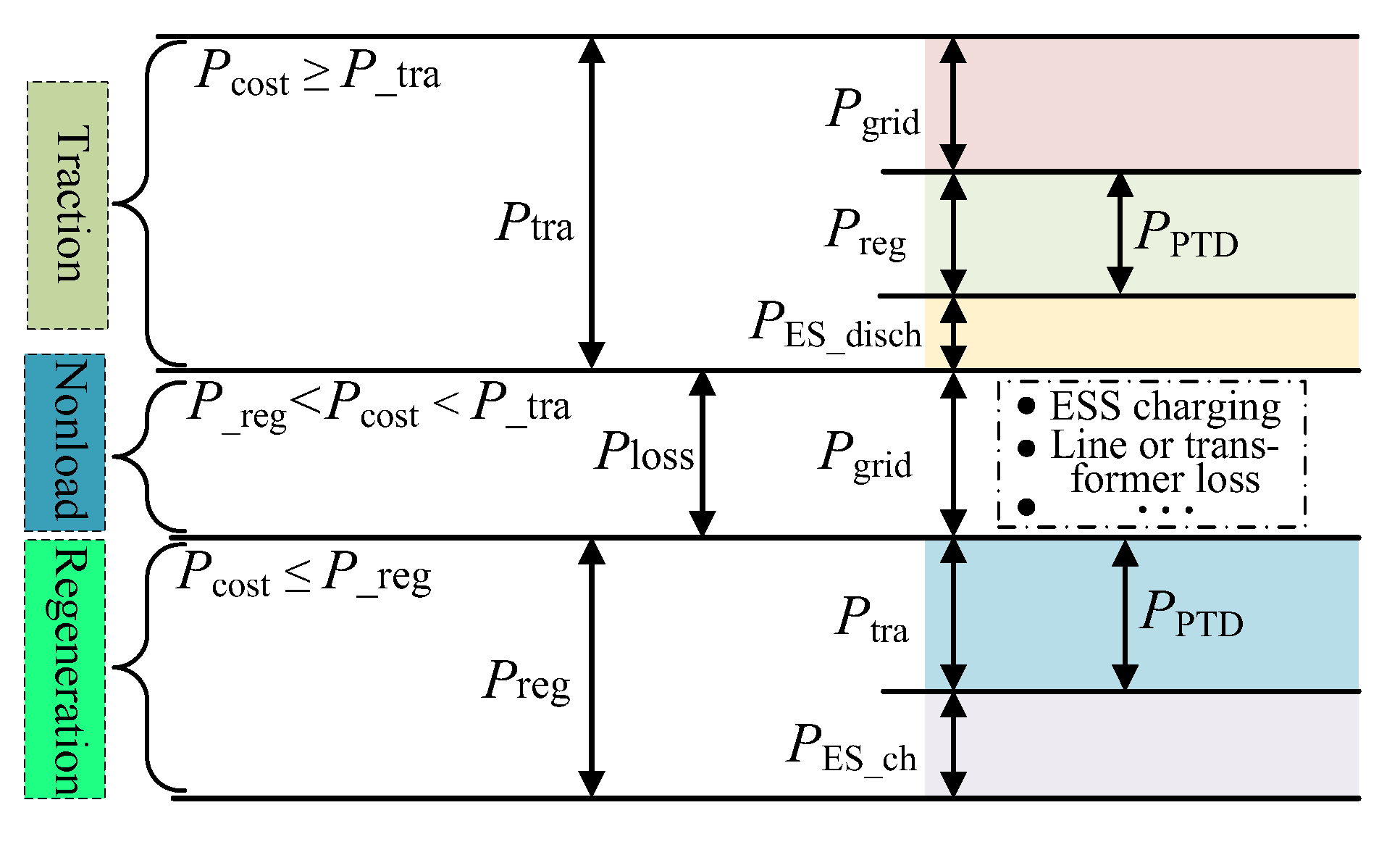
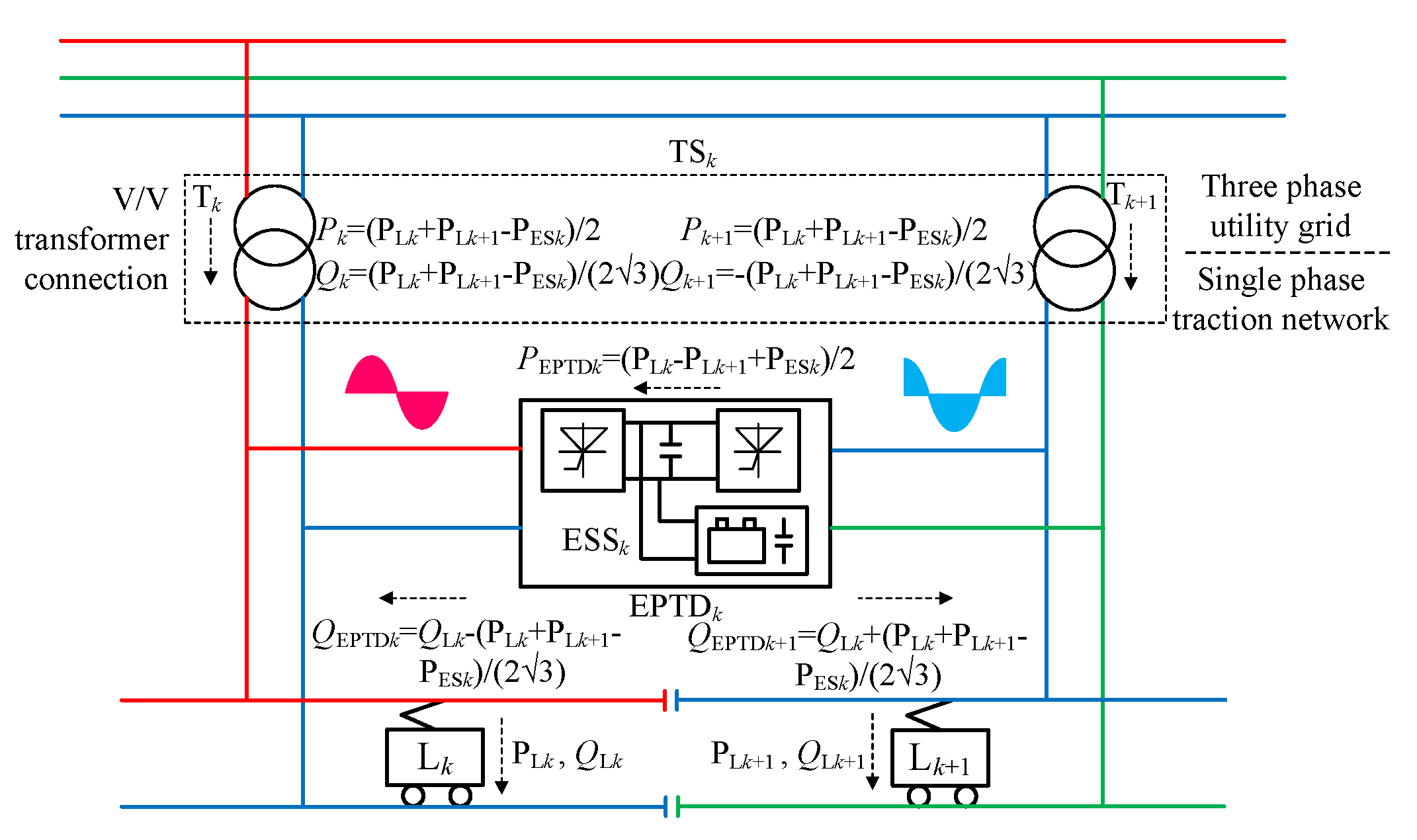

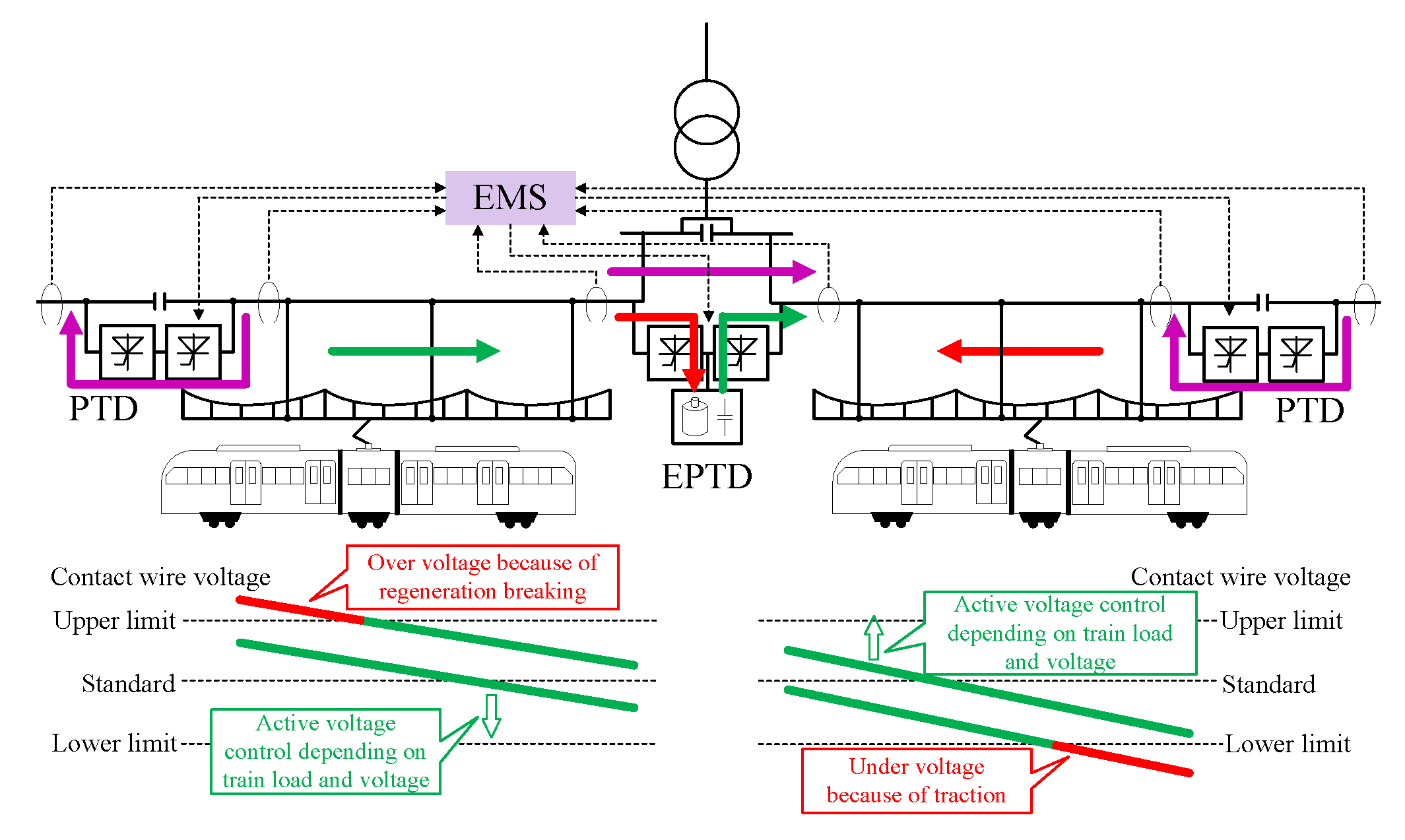
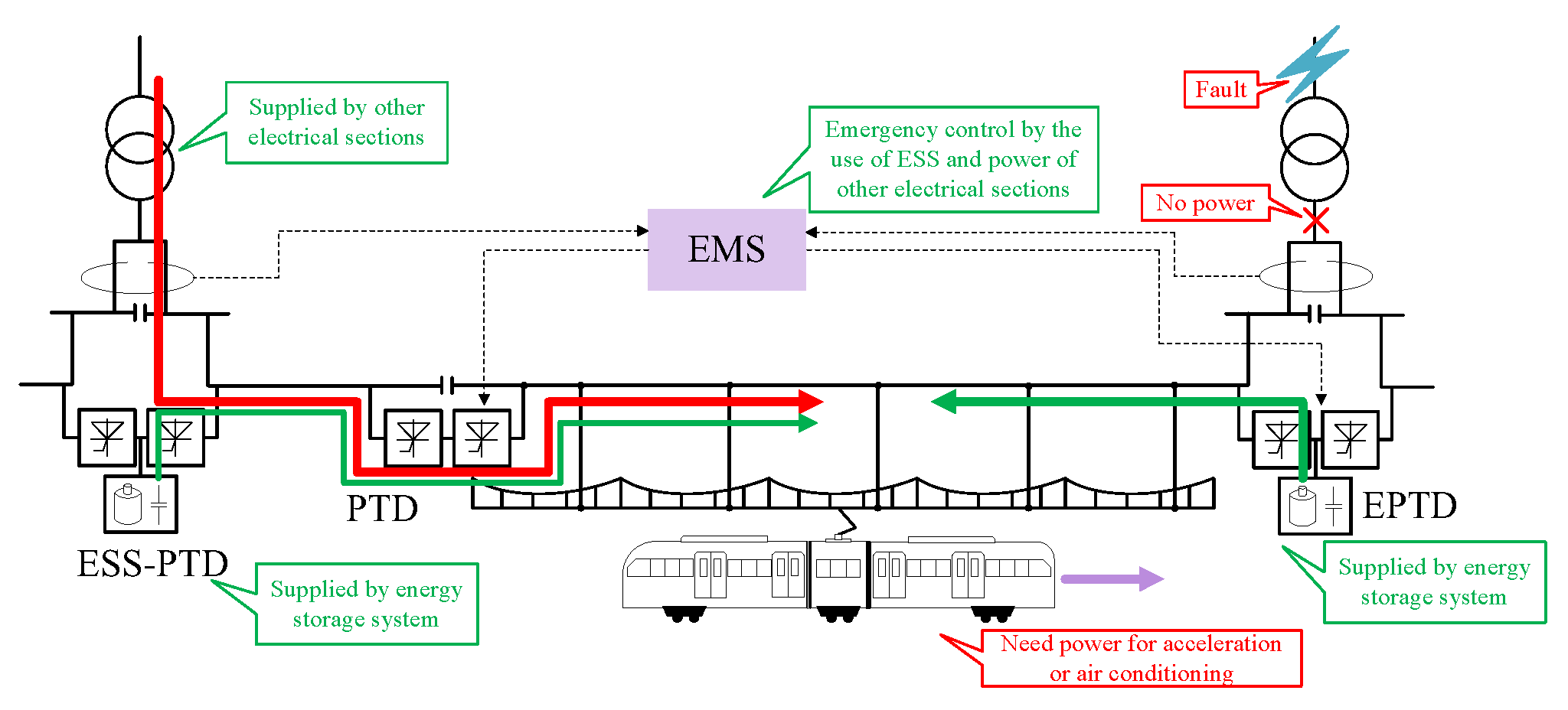

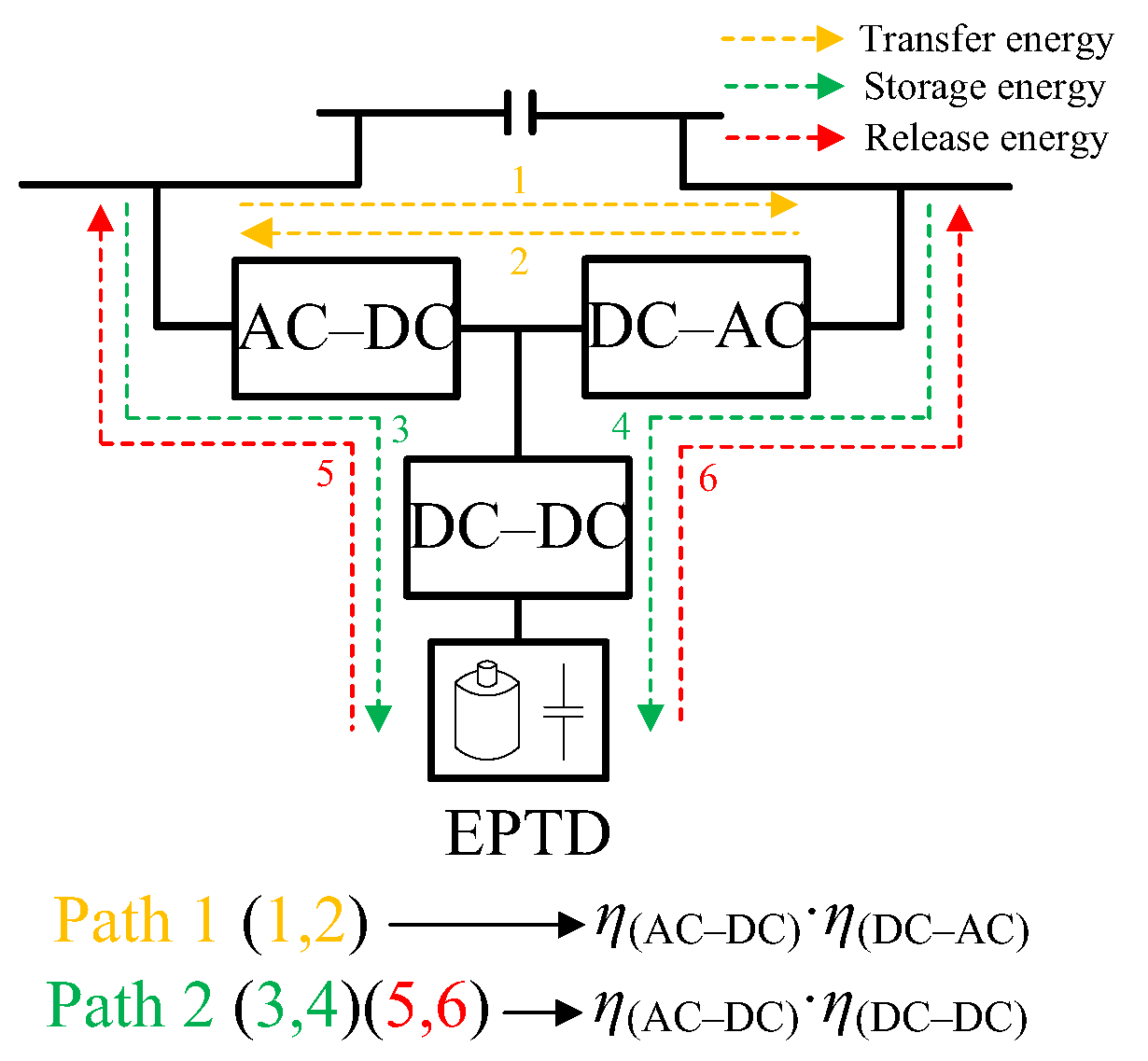
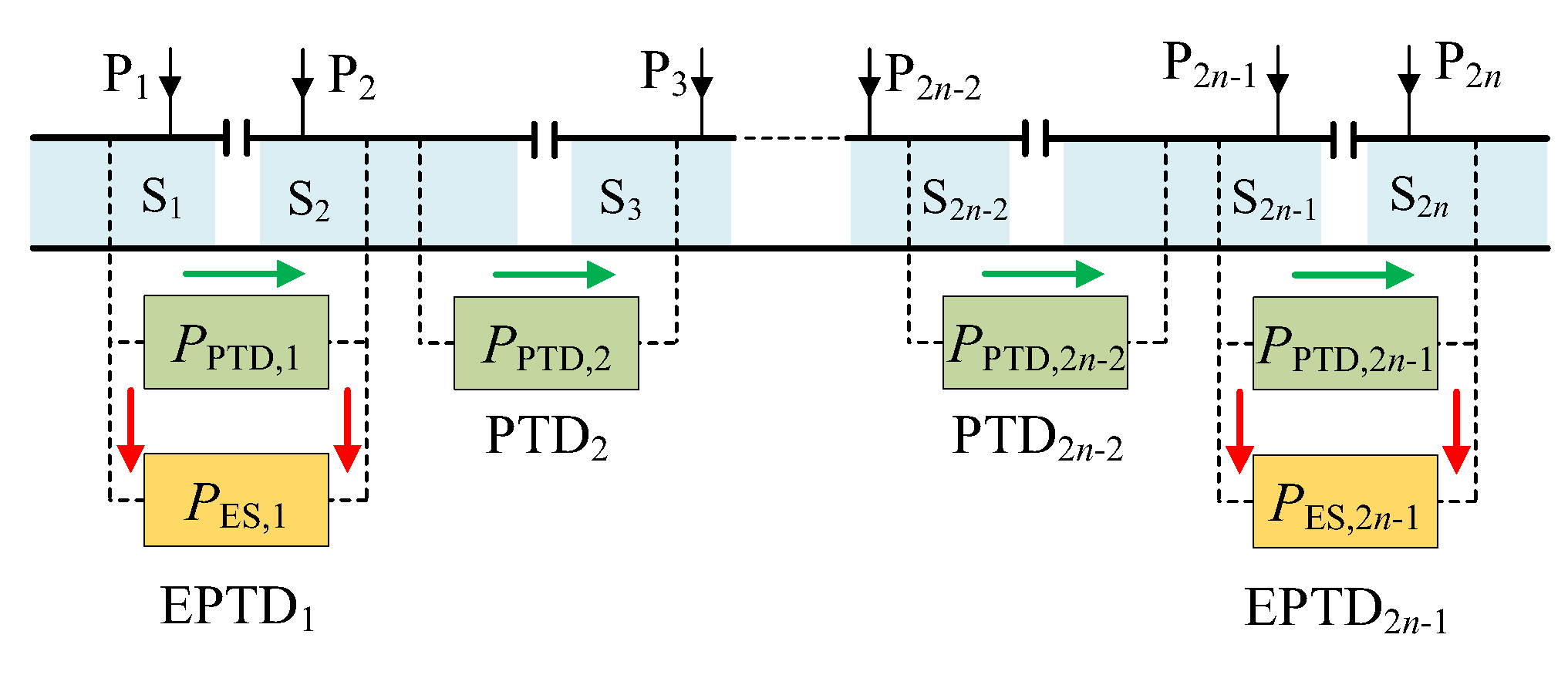
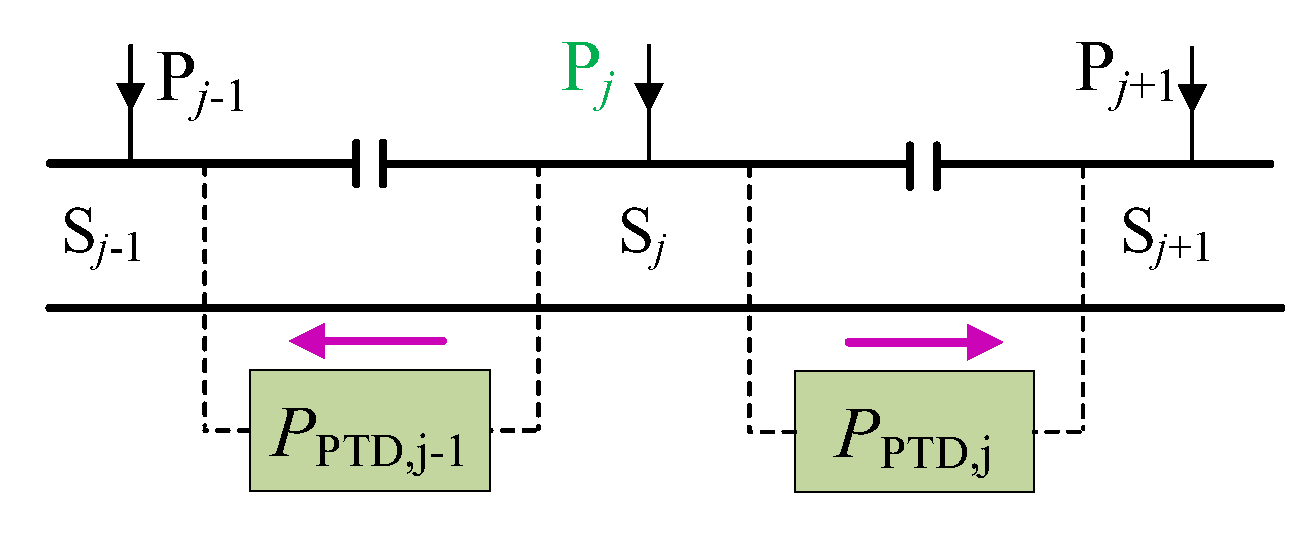

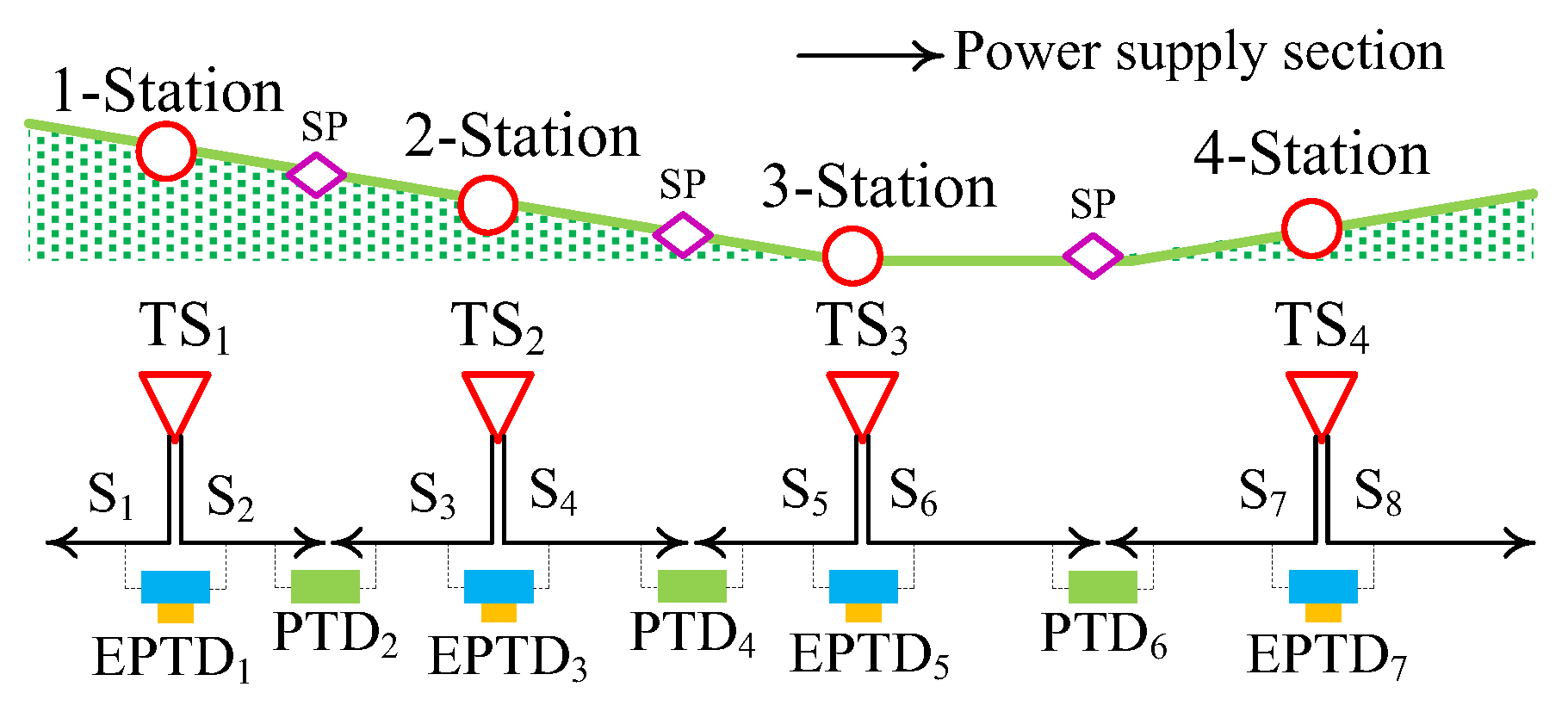
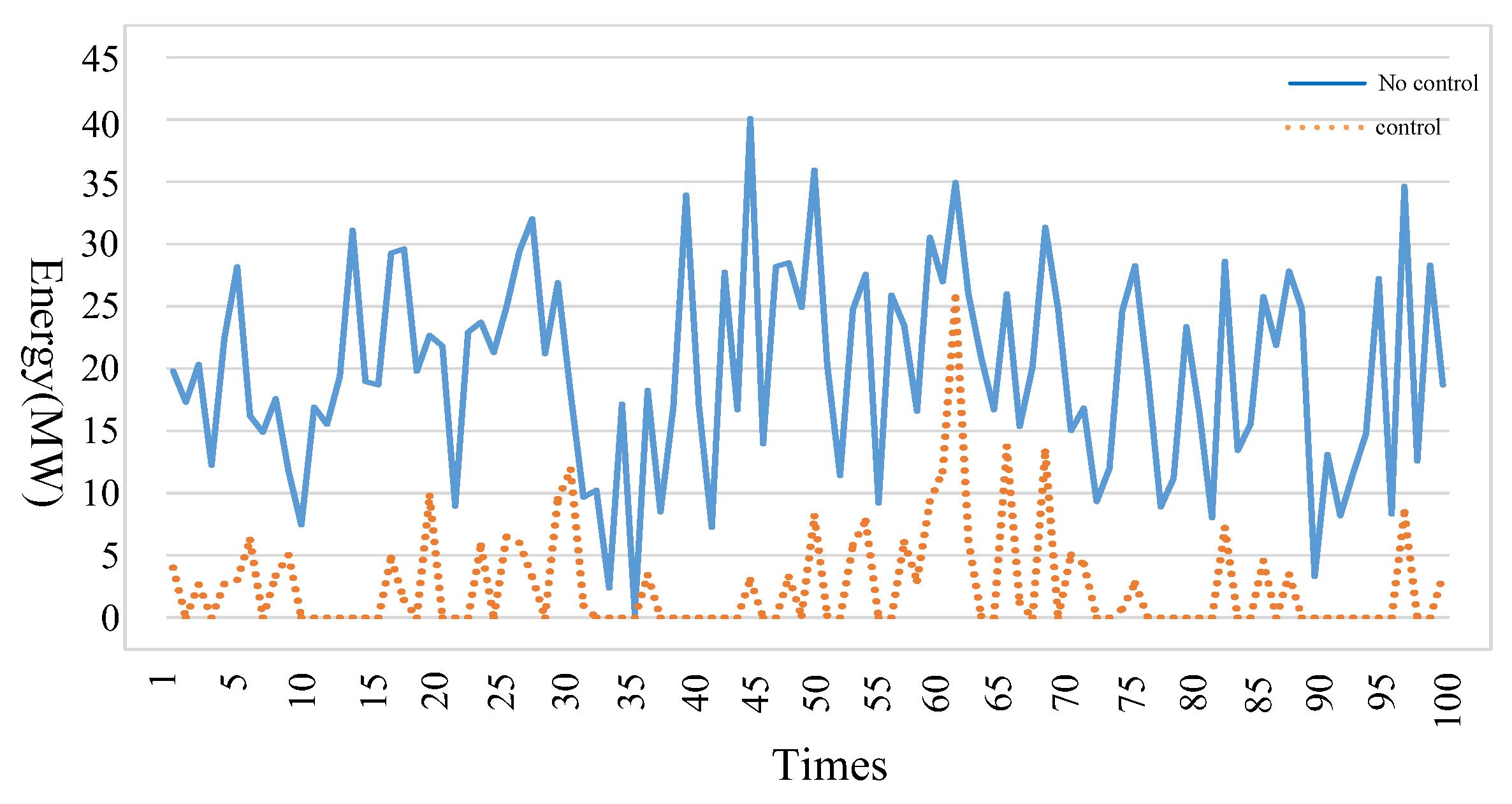
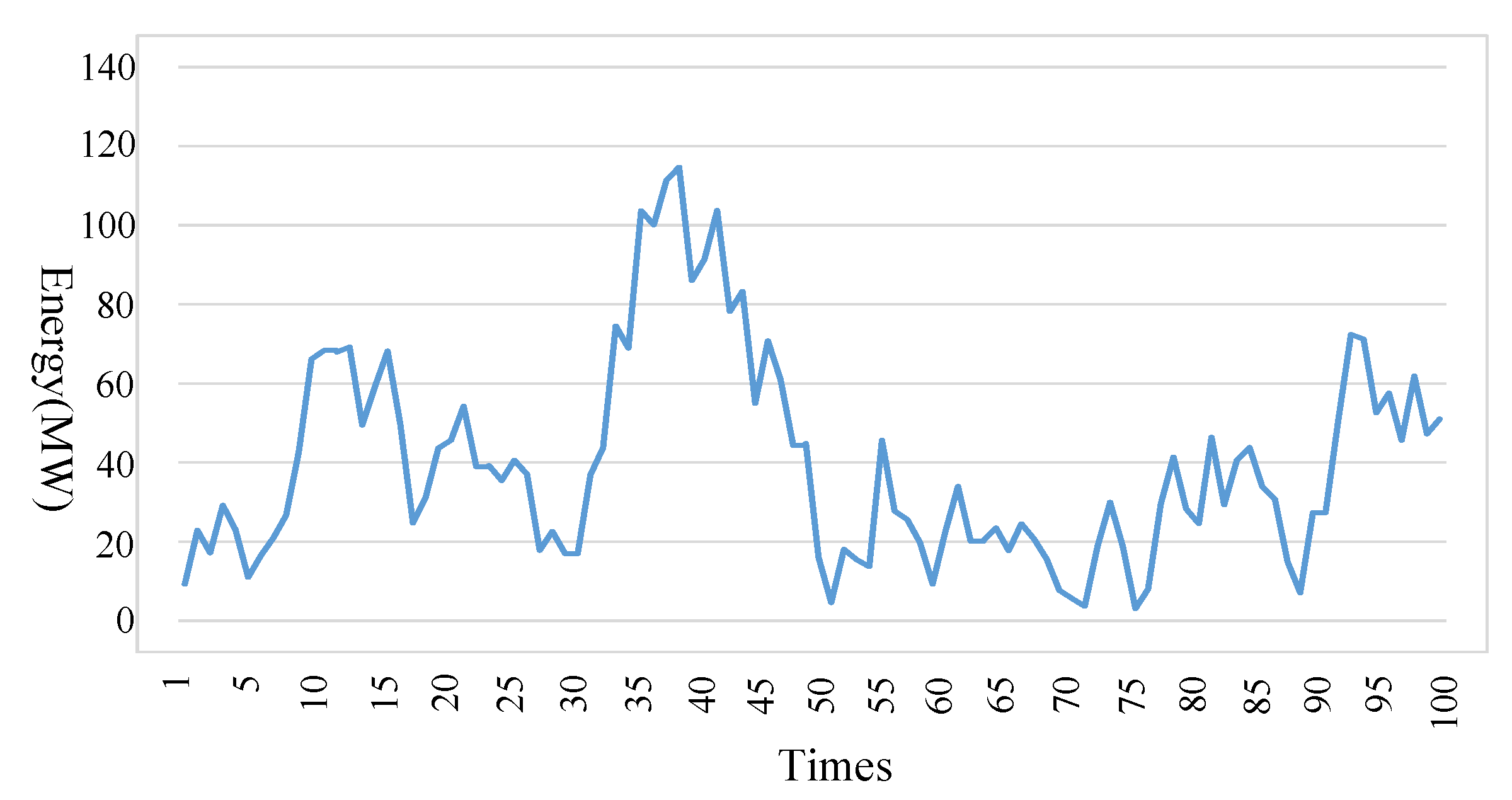
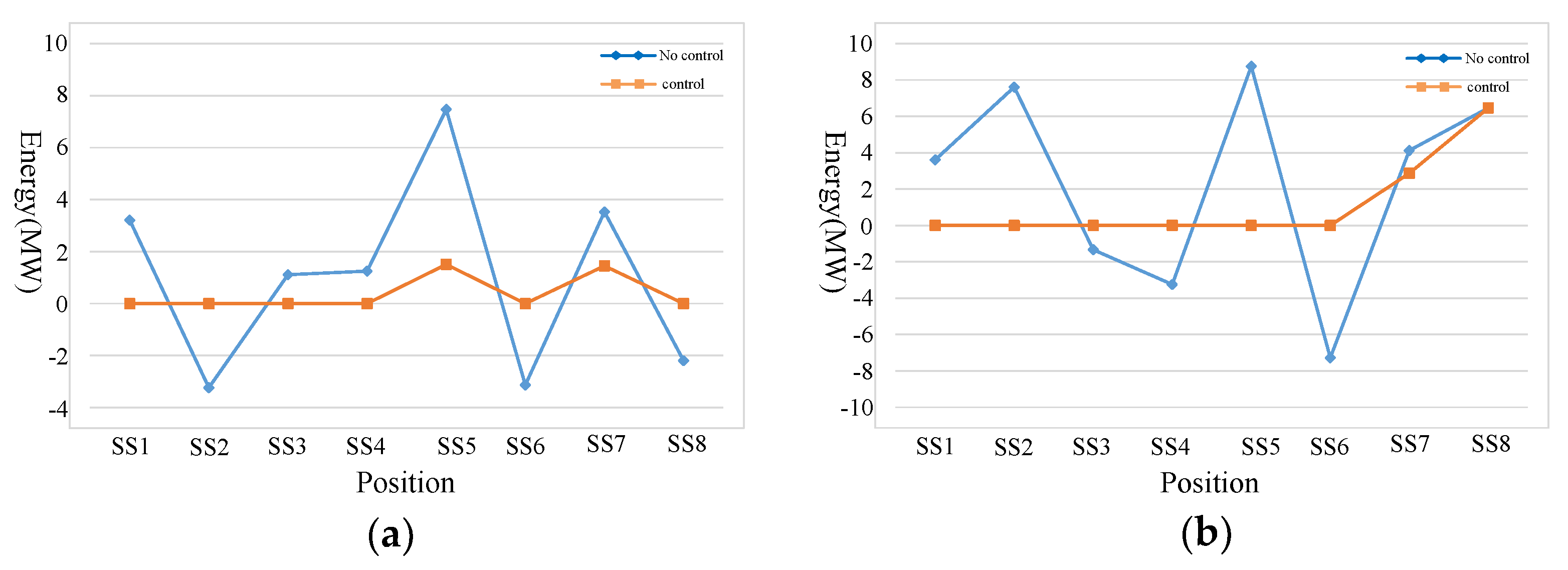
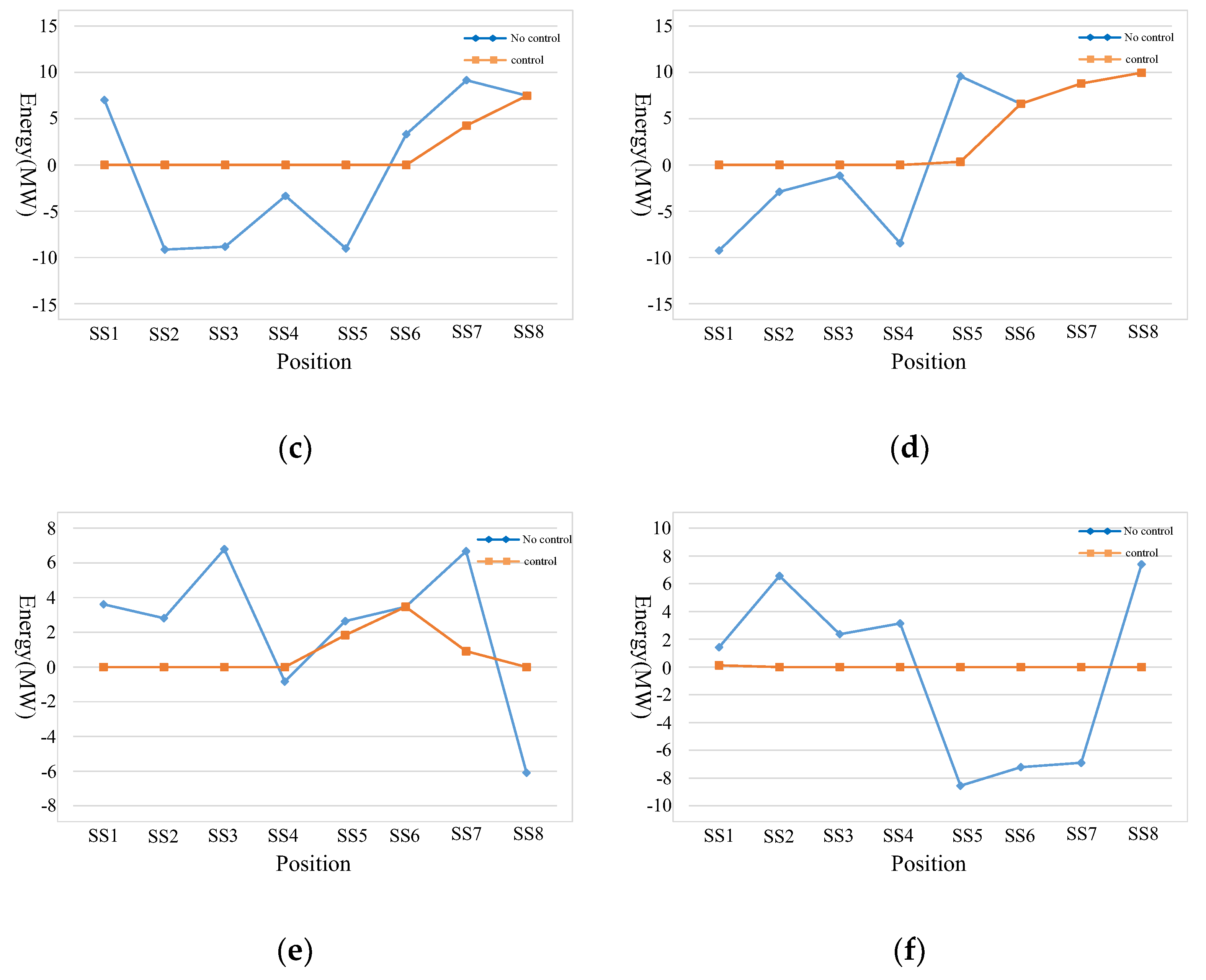
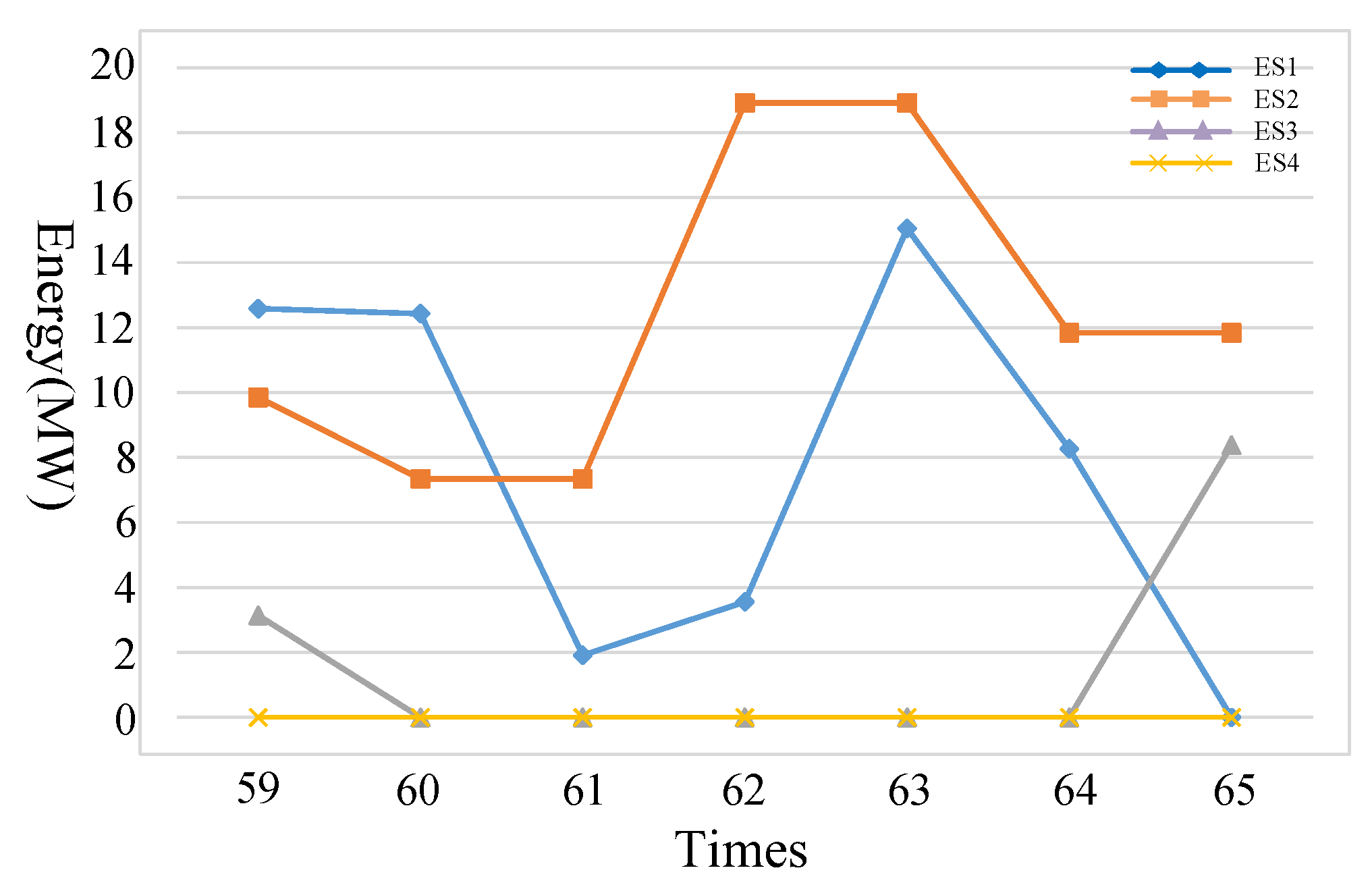

| Type | η(AC−DC) | η(DC−AC) | η(DC−DC) |
|---|---|---|---|
| EPTD1 | 0.9690 | 0.9756 | 0.9753 |
| PTD2 | 0.9609 | 0.9665 | − |
| EPTD3 | 0.9861 | 0.9501 | 0.9736 |
| PTD4 | 0.9886 | 0.9790 | - |
| EPTD5 | 0.9847 | 0.9586 | 0.9721 |
| PTD6 | 0.9810 | 0.9597 | - |
| EPTD7 | 0.9881 | 0.9575 | 0.9786 |
© 2019 by the authors. Licensee MDPI, Basel, Switzerland. This article is an open access article distributed under the terms and conditions of the Creative Commons Attribution (CC BY) license (http://creativecommons.org/licenses/by/4.0/).
Share and Cite
Gao, Z.; Lu, Q.; Wang, C.; Fu, J.; He, B. Energy-Storage-Based Smart Electrical Infrastructure and Regenerative Braking Energy Management in AC-Fed Railways with Neutral Zones. Energies 2019, 12, 4053. https://doi.org/10.3390/en12214053
Gao Z, Lu Q, Wang C, Fu J, He B. Energy-Storage-Based Smart Electrical Infrastructure and Regenerative Braking Energy Management in AC-Fed Railways with Neutral Zones. Energies. 2019; 12(21):4053. https://doi.org/10.3390/en12214053
Chicago/Turabian StyleGao, Zhixuan, Qiwei Lu, Cong Wang, Junqing Fu, and Bangbang He. 2019. "Energy-Storage-Based Smart Electrical Infrastructure and Regenerative Braking Energy Management in AC-Fed Railways with Neutral Zones" Energies 12, no. 21: 4053. https://doi.org/10.3390/en12214053
APA StyleGao, Z., Lu, Q., Wang, C., Fu, J., & He, B. (2019). Energy-Storage-Based Smart Electrical Infrastructure and Regenerative Braking Energy Management in AC-Fed Railways with Neutral Zones. Energies, 12(21), 4053. https://doi.org/10.3390/en12214053





